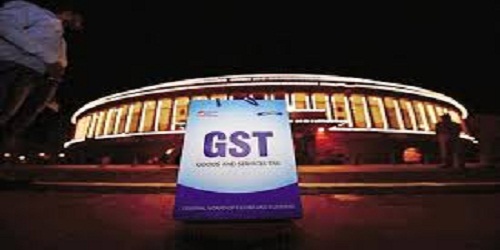The Central Government has proposed a four-slab rate structure for the Goods & Services Tax, ranging from zero to 26 per cent, at a meeting of the GST Council.
About GST,
Goods and Services Tax (GST)is a proposed system of indirect taxation in India merging most of the existing taxes into single system of taxation.
- “Goods and Services Tax” would be a comprehensive indirect tax on manufacture, sale and consumption of goods and services throughout India, to replace taxes levied by the central and state
- Goods and Services Tax would be levied and collected at each stage of sale or purchase of goods or services based on the input tax credit method. This method allows GST-registered businesses to claimtax credit to the value of GST they paid on purchase of goods or services as part of their normal commercial activity.

- Taxable goods and services are not distinguished from one another and are taxed at a single rate in a supply chain till the goods or services reach the consumer. Administrative responsibility would generally rest with a single authority to levy tax on goods and services.
- Exports would be zero-rated and imports would be levied the same taxes as domestic goods and services adhering to the destination principle.
- The Goods and Services Tax Bill or GST Bill, officially known as The Constitution (One Hundred One Amendment) Bill, 2014, proposes a national Value added Tax to be implemented in India from 1 April 2017.
- The introduction of Goods and Services Tax (GST) would be a significant step in the reform of indirect taxation in India. Amalgamating several Central and State taxes into a single tax would mitigate cascading or double taxation, facilitating a common national market.
- The simplicity of the tax should lead to easier administration and enforcement. From the consumer point of view, the biggest advantage would be in terms of a reduction in the overall tax burden on goods, which is currently estimated at 25%-30%, free movement of goods from one state to another without stopping at state borders for hours for payment of state tax or entry tax and reduction in paperwork to a large extent.
- What changes there would be if India launches GST- “The tax rate under GST may be nominal or zero rated for the time being. It has been proposed to insulate the revenues of the States from the impact of GST, with the expectation that in due course, GST will be levied on petroleum and petroleum products.”
- The central government has assured states of compensation for any revenue losses incurred by them from the date of introduction of GST for a period of five years.
About the Slabs :
On consumption of ultra-luxury items and demerit goods, such as big cars and tobacco products, it proposes imposition of cess over and above a 26 per cent GST rate. The GST is proposed to be levied at 6 per cent, 12 per cent or 18 per cent on the remaining goods and services.
- This proposal singles out gold, for which it proposes a GST rate of 4 per cent. “The principle for determining the rate on each item being proposed is to levy and collect the GST at the rate slab closest to the current tax incidence on it.
- The rate proposed on all items is by and large lower than the current rate. In the 26 per cent slab, for instance, currently most goods are being taxed at about 27 to 31 per cent.
- The proposal retains only the Clean Environment Cess from the multitude currently in place, with the GST subsuming all the others, including the Swachh Bharat Cess, the Krishi Kalayan Cess and the Education Cess.
- The proposal envisages 10 per cent of the current tax revenue collections base to fall in the 6 per cent GST slab and about 70 per cent in the 12 per cent and 18 per cent slabs. About 25 per cent of the current tax revenue base falls in the proposed 26 per cent slab, including items that will attract cess.
AffairsCloud Recommends Oliveboard Mock Test
AffairsCloud Ebook - Support Us to Grow
Govt Jobs by Category
Bank Jobs Notification





